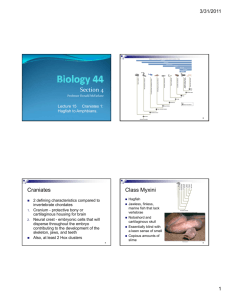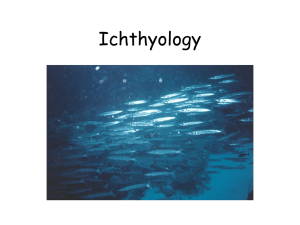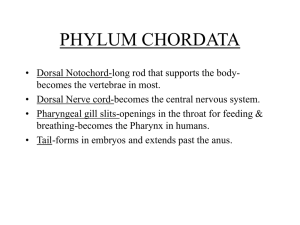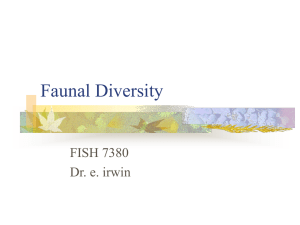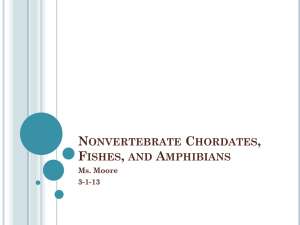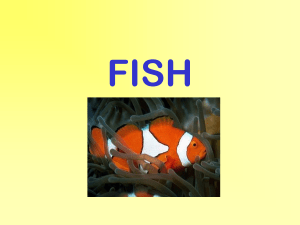Diversity of Fishes III
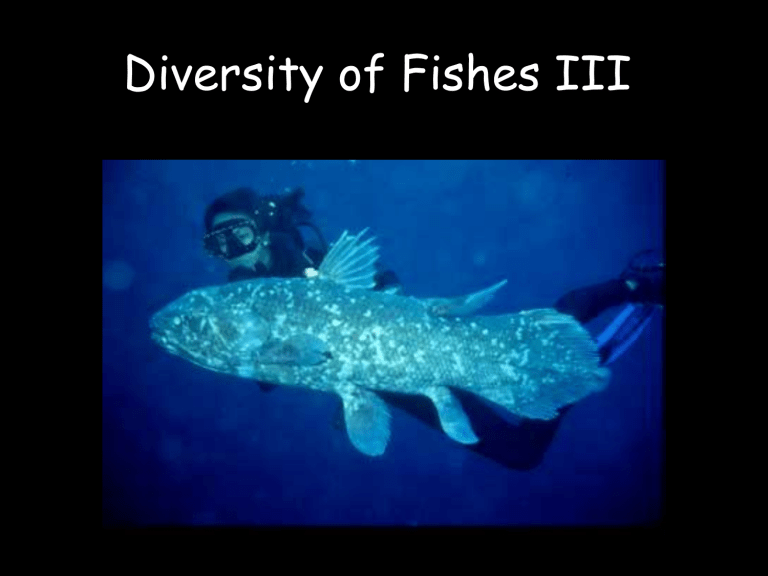
Diversity of Fishes III
Fish Taxa Diversity
• Phylum Chordata
– Superclass Agnatha
• Class Pteraspidomorphi †
• Class Myxini (?)
• Class Cephalaspidomorphi
– Superclass Gnathostomata
• Class Placodermi †
• Class Chondrychthyes
• Class Acanthodii †
• Class Sarcopterygii
• Class Actinopterygii
Evolution of Fishes
Superclass Gnathostomata
(still)
• Class Acanthodii
†
(“spiny sharks”)
– Cartilaginous skeletons with ossified pieces & characteristic spines
– Pelagic habitat (FW & SW)
– Considered sister group of bony fish
Teleostomi or Osteichthyes
(Bony Fishes)
Superclass Gnathostomata
• Class Sarcopterygii (lobed fins)
– Coelacanths and lungfishes
– Osteolepimorphi †
• Class Actinopterygii (ray fins)
- Ray finned fishes
Class Sarcopterygii
• Order Coelacanthiformes
– Family Coelacanthidae (coelecanths)
- Fleshy lobed fins
- Characteristic osteological features (fig 13.6)
- Choanae (internal nostrils)
- 2 spp.
Latimeria chalumane
(“Old fourlegs”)
• Marjorie Courtenay-Latimer (1939)
• J. L. B. Smith
– 2 nd specimen (1952)
• Comoro Islands (now Kenia, Madagascar,
South Africa…)
• French embargo
• Conservation issues
• Live observations (nocturnal, 200m)
• Ovoviviparous
Latimeria menadoensis
(“King of the Sea”)
• Mark Erdmann (1998)
• Indonesia (Sulawesi)
• Conservation issues
• Genetics study
• Live observations
Other Coelacanth Locations?
Meso-american silver jewelry
1800’s
Extra Credit: +3% total grade
A Fish Caught in Time : The
Search for the Coelacanth by Samantha Weinberg ($10.50
@ www.amazon.com)
Read the book, and write a 1 page essay, clearly expressing YOUR interpretation and opinions of it, as well as how the reading affected your opinion on ichthyology.
Class
Sarcopterygii
• Infraclass Dipnoi (lungfishes)
– Massive toothplates
– Maxillae and Premaxillae bones missing
– Functional Lung, choanae (internal nostrils)
– Family Ceratodontidae (Australia, 1spp.)
– Family Lepidosirenidae (S. America, 1spp.)
– Family Protopteridae (Africa, 4 spp.)
Ceratodontidae
Australian lungfish
Neoceratus forsteri
Protopteridae
African lungfishes
Protopterus sp.
Lepidosirenidae
S. American lungfish
Lepidosiren paradoxa
Class
Sarcopterygii
• Infraclass Osteolepimorphi †
– Sister group of modern tetrapods
– Similar fins to Devonian Amphibians limbs
– Other morphological similarities
Teleostomi or Osteichthyes
(Bony Fishes)
Class
Actinopterygii
Class
Actinopterygii
Class Actinopterygii
• Order Polypteriformes
– Family Polypteridae (bichirs & reedfish)
• 10 spp. (African rivers)
• Facultative airbreathers (spiracle exhalation)
• Lobed fins, ganoid scales, heterocercal tail, spiral intestine.
• Flagfins (vertical spine with horizontal rays)
Class Actinopterygii
• Order Acipenseriformes
(secondary cartilaginous skeleton, heterocercal tail, fin rays, spiral valve intestine). Sturgeons and Paddlefish
– Family Acipenseridae (sturgeons)
• 24 spp. (northern hemisphere)
• 5 rows bony scutes (modified ganoid scales)
• 4 barbels in front of ventral mouth
• Fresh water spawning (typically Anadromous)
Class Actinopterygii
• Order Acipenseriformes
(secondary cartilaginous skeleton, heterocercal tail, fin rays, spiral valve intestine)
– Family Polyodontidae (paddlefishes)
• 2 spp. (N. American and Chinese paddlefishes)
• No bony scutes, small scales, ossified head plates
• Freshwater open water plankton feeders
• Paddle as electroreceptor?
Class Actinopterygii
• Order Semionotiformes
– Family Lepisosteidae (garfish)
• 7spp. (North and Central America)
• Ossified skeleton
• Ganoid scales
• Slightly heterocercal caudal fin
• Backwaters in lakes and rivers, predatory fish
• Toxic eggs
Class Actinopterygii
• Order Amiiformes
– Family Amiidae (bowfin)
• 1 spp. (Amia calva, Eastern North America)
• Ossified skeleton
• Slightly heterocercal caudal fin
• Cycloid scales
• Swims through dorsal fin ondulations
• Backwaters in lakes and rivers


